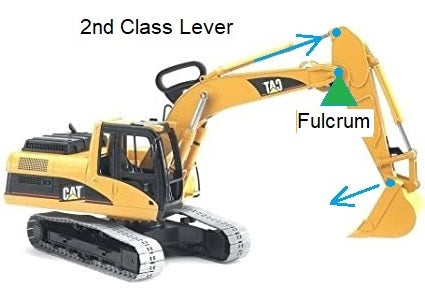How do you calculate a 3rd Class Lever

A third-class lever is a type of lever in which the effort arm is located between the fulcrum and the load. The load arm is always longer than the effort arm. Unlike first and second-class levers, a third-class lever does not amplify force. Instead, it is used to increase the speed or distance of movement of the load.
The main difference between a third-class lever and a second-class lever is the position of the effort and the load relative to the fulcrum.
In a second-class lever, the load is located between the fulcrum and the effort, whereas in a third-class lever, the effort is located between the fulcrum and the load. The effort arm is always longer than the load arm in a second-class lever, while the load arm is always longer than the effort arm in a third-class lever. Its wirth remembering that in a 3rd class lever, the force required to lift the load is significantly more than in a second class lever. Try the calculator below to see the difference in loads.
Another key difference is in the way the levers operate. A second-class lever is designed to amplify force, allowing a smaller effort to move a larger load. On the other hand, a third-class lever is designed to increase the speed or distance of movement of the load, at the expense of the force required to move it.
The formula to calculate the effort required in a third-class lever is:
Effort x Effort Arm = Load x Load Arm
where:
- Effort: the force applied to the lever to move the load
- Effort Arm: the distance from the fulcrum to the point where the effort is applied
- Load: the weight or resistance being moved by the lever
- Load Arm: the distance from the fulcrum to the point where the load is applied
To find any of the variables in the equation, the other three variables must be known.

Calculator for a 3rd Class Lever
Results
Unknown Force Required F2:
0 lbs
0 N
0 kg
0 g
0 tonnes
Examples of 3rd Class Levers
One real-world example of a third-class lever is the human arm. The elbow joint acts as the fulcrum, the bicep muscle provides the effort, and the hand holding a weight acts as the load. By bending the elbow joint, the bicep muscle is able to move the load (the weight in the hand) towards the shoulder, increasing the distance traveled by the load.
Other examples of third-class levers include tweezers, fishing rods, shovels, and brooms.
A calculator for a third-class lever can be useful for engineers, hobbyists, and DIY enthusiasts who need to determine the force or effort required to move a load using a lever. It can help to optimize the design of a lever by finding the best location for the effort and load to achieve the desired movement or force.
When does a 2nd class lever become a 3rd class lever
A lever cannot change its class directly, as each class of lever has a specific arrangement of the components: effort, load, and fulcrum. The three classes of levers are defined by the relative positions of these components:
- First-class lever: The fulcrum is between the effort and the load.
- Second-class lever: The load is between the fulcrum and the effort.
- Third-class lever: The effort is between the fulcrum and the load.
A 2nd class lever cannot become a 3rd class lever simply by changing the applied force or load. Instead, the arrangement of the lever components must be altered. If the effort moves to a position between the fulcrum and the load, the lever will become a 3rd class lever.
To understand the other classes of levers, we have created some blog posts on those shown below:
1st class lever calculator
2nd class lever calculator
3rd Class lever calculator
Real world example of a 2nd and 3rd Class lever

